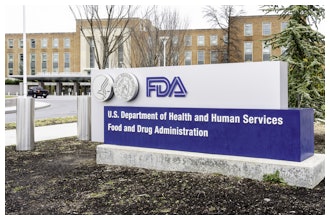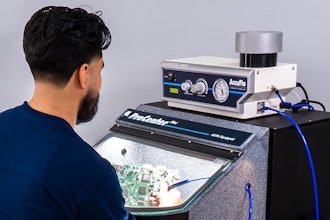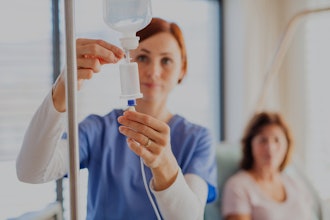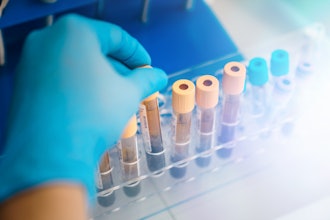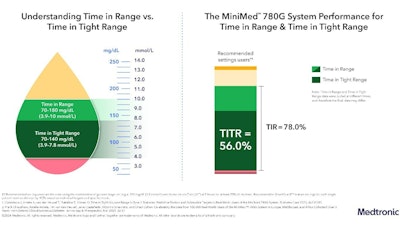
On Saturday, Medtronic shared a set of new clinical and real-world evidence on the MiniMed™ 780G system from around the world including the largest set of data from early users in the United States. The data was presented at the 17th International Conference on Advanced Technologies and Treatments for Diabetes (ATTD) in Florence, Italy.
The results build on the three-year data published in Diabetes Technology & Therapeutics showing over 100,000 real-world users achieving a Time in Range (TIR) of 78% with the use of recommended optimal settings, outperforming international targets of 70% TIR.
New data sought to evaluate the MiniMed™ 780G system's ability to help users achieve Time in Tight Range (TITR) goals, a new and emerging supplementary metric being discussed amongst experts, which more closely mirrors the glucose levels of individuals without diabetes. Also referred to as normoglycemia or euglycemia, it is defined as the percentage of time a person spends in the glucose range of 70-140 mg/dL.
TITR lowers the upper threshold of Time in Range from 180 mg/dL to 140 mg/dL. Results showed users (n=13,461) achieved a TITR of greater than 56% with the use of recommended optimal settings (100 mg/dL set target with an active insulin time of 2 hours). This data adds to a growing body of evidence that a TITR goal of 50% or greater is a reasonably achievable goal with the right therapeutic option.
"Since the landmark DCCT study, numerous retrospective studies have demonstrated the association between increased Time in Range and a reduction of diabetic complications.1-12 There's no doubt elevated glucose is harmful and the average blood sugars of those living with type 1 diabetes are higher than we should accept as a clinical community," said Robert Vigersky, MD, Chief Medical Officer, Medtronic Diabetes. "The preponderance of data across randomized controlled trials and real-world studies show that the MiniMed™ 780G system is maximizing Time in Range far surpassing international targets and is taking it a step beyond by getting people closer to euglycemia.13,14 In the absence of a cure, our goal is to relentlessly innovate therapies to help people maximize their health without adding burden, which our newest AID system has proven to do."
In an oral presentation, Dr. James Thrasher, MD, Founder, Arkansas Diabetes and Endocrinology Center, shared data on early real-world users with type 1 diabetes of the MiniMed™ 780G system in the U.S. (n=7,499). Results showed users achieved over 80% TIR when employing the recommended optimal settings, exceeding international glycemic targets (ADA guidelines recommend 70% time in range between 70-180 mg/dL), with closed loop exits occurring less than once per week on average. The enhancements introduced in this latest system have resulted in high satisfaction and improved quality of life benefits.15,16 Indeed, the latest dQ&A(opens new window) U.S. Pump Patient Survey (n=1,997), found that among pump users, the MiniMed™ 780G system scored first in overall pump satisfaction.*,17 The survey also showed that among people with type 1 diabetes using CGM, the Guardian™ 4 sensor mirrored competitor sensors in overall satisfaction.*,18
"The results demonstrate that when the MiniMed™ 780G system is optimized with recommended optimal settings, it helps people with diabetes far exceed the ADA recommended goal of 70% Time in Range,*" said Dr. Thrasher. "The advent of AID systems has been nothing short of transformative in the practice of endocrinology and is really pushing all of us to introduce its protective benefits on overall health as early and often as possible. This data reinforces that the determinant of choice for AID systems should be first and foremost the power of the algorithm."
The development of continuous glucose monitoring enabled the development of Time in Range (TIR), a metric used today to determine whether an individual with type 1 diabetes is meeting blood sugar management goals. Since 2019, the goal of diabetes management has been to maintain the highest TIR for as long as possible while also minimizing hypoglycemia. The introduction of automated insulin delivery (AID) systems has transformed diabetes care by enabling a wider range of individuals to safely achieve blood-sugar goals with less burden and effort. AID systems are helping people achieve more ambitious goals with glucose management, prompting the emergence of a new supplementary metric that mirrors blood sugar levels of individuals without diabetes (normoglycemia or euglycemia). The MiniMed™ 780G system is demonstrating that a Time in Tight Range above 50 percent is achievable and serves as a powerful tool for those seeking more time in euglycemia.
*Adults, T1 and parents of children with T1 diabetes < 18 years were surveyed; Individual results may vary.
- Yapanis M, James S, Craig ME, et al. Complications of Diabetes and metrics of glycemic management derived from continuous glucose monitoring. J Clin Endocrinol Metab 2022;107(6):e2221–e2236
- Beck RW, Bergenstal RM, Riddlesworth TD, et al. Validation of time in range as an outcome measure for diabetes clinical trials. Diabetes Care 2019;42(3):400–405
- Lu J, Ma X, Zhou J, et al. Association of time in range, as assessed by continuous glucose monitoring, with diabetic retinopathy in type 2 diabetes. Diabetes Care 2018;41(11):2370–2376
- Raj R, Mishra R, Jha N, et al. Time in range, as measured by continuous glucose monitor, as a predictor of microvascular complications in type 2 diabetes: A systematic review. BMJ Open Diab Res Care 2022;10(1):e002573
- Lu J, Ma X, Shen Y, et al. Time in range is associated with carotid intima-media thickness in type 2 diabetes. Diabetes Technol Ther 2020;22(2):72–78
- Yoo JH, Choi MS, Ahn J, et al. Association between continuous glucose monitoring-derived time in range, other core metrics, and albuminuria in type 2 diabetes. Diabetes Technol Ther 2020;22(10):768–776
- Yang J, Yang X, Zhao D, et al. Association of time in range, as assessed by continuous glucose monitoring, with painful diabetic polyneuropathy. J Diabetes Invest 2021;12(5):828–836
- Hirsch IB, Sherr JL, Hood KK. Connecting the dots: Validation of time in range metrics with microvascular outcomes. Diabetes Care 2019;42(3):345–348
- Mayeda L, Katz R, Ahmad I, et al. Glucose time in range and peripheral neuropathy in type 2 diabetes mellitus and chronic kidney disease. BMJ Open diabetes Res Care 2020;8(1):e000991
- El Malahi A, Van Elsen M, Charleer S, et al. Relationship between time in range, glycemic variability, HbA1c, and complications in adults with type 1 diabetes mellitus. J Clin Endocrinol Metab 2022;107(2):e570–e581
- Beck RW. The association of time in range and diabetic complications: The evidence is strong. Diabetes Technol Ther 2023;25(6):375–377
- Zhu DD, Wu X, Cheng XX, et al. Time in range as a useful marker for evaluating retinal functional changes in diabetic retinopathy patients. Int J Ophthalmol 2023;16(6):915–920
- CGM & Time in Range. American Diabetes Association. Available at: https://diabetes.org/tools-support/devices-technology/cgm-time-in-range. Accessed June 19, 2023.
- American Diabetes Association (2019). Standards of medical care in diabetes—2019. Diabetes Care, 42(Suppl 1): S61-S70.
- MiniMed™ 780G system SSED
- Medtronic data on file: MiniMed™780G users survey conducted in April – May 202in UK, Sweden, Italy, Netherlands and Belgium. N 789
- dQ&A US Diabetes Patient Panel Report; Customer Overall Satisfaction, n=146; Q4 2023: P.52 (November 2023)
- dQ&A US Diabetes Patient Panel Report; Customer Overall Satisfaction, n=207; Q4 2023: P.85 (November 2023)











